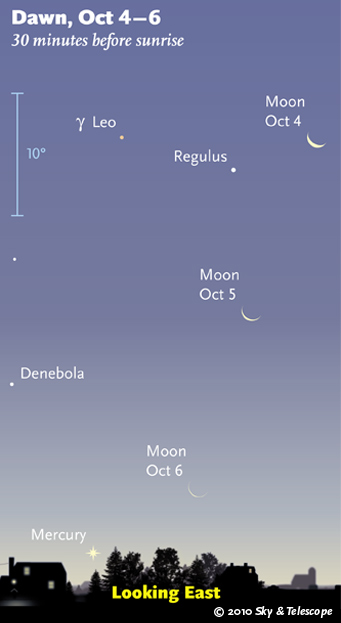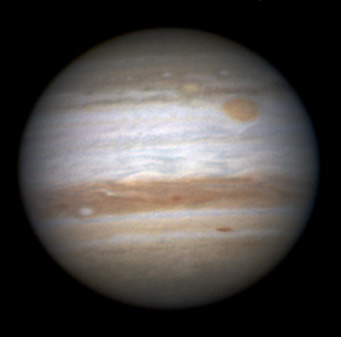
During the current dark-of-the-Moon period, Comet Hartley 2 passes south of Cassiopeia high in the evening sky. Click image for larger charts. The comet symbols are placed at 0:00 UT on the September and October dates indicated. Remember, 0:00 UT falls on the evening of the previous date in the times zones of the Americas.
Sky & Telescope
Periodic Comet Hartley 2 is about 7th magnitude, visible in binoculars in a dark sky. It's excellently placed very high these moonless evenings, passing just south of Cassiopeia as shown at right. But it's large and diffuse, meaning its light is spread out over a wide area (as seen in binoculars) — so you'll need an unpolluted dark sky. Binocular observers have been calling it easy from rural areas and invisible from suburbs.
Hartley 2 may brighten to 5th magnitude overall in the next couple weeks. See the article in the October Sky & Telescope, page 56, or online.
Friday, October 1
Saturday, Oct. 2
Sunday, October 3

In the dawn sky, the waning crescent Moon descends steeply day by day past Regulus toward low Mercury. (The visibility of objects in bright twilight is exaggerated here. The scene is drawn for the middle of North America. European observers: move each Moon symbol a quarter of the way toward the one for the previous date. The blue 10° scale is about the size of your fist held at arm's length.)
Sky & Telescope diagram
Monday, October 4
Tuesday, October 5
Wednesday, October 6
Thursday, October 7
Friday, October 8
Saturday, October 9
Want to become a better amateur astronomer? Learn your way around the constellations. They're the key to locating everything fainter and deeper to hunt with binoculars or a telescope.
For an easy-to-use constellation guide covering the whole evening sky, use the big monthly map in the center of each issue of Sky & Telescope, the essential magazine of astronomy. Or download our free Getting Started in Astronomy booklet (which only has bimonthly maps).

The Pocket Sky Atlas plots 30,796 stars to magnitude 7.6 — which may sound like a lot, but that's less than one star in an entire telescopic field of view, on average. By comparison, Sky Atlas 2000.0 plots 81,312 stars to magnitude 8.5, typically one or two stars per telescopic field. Both atlases include many hundreds of deep-sky targets — galaxies, star clusters, and nebulae — to hunt among the stars.
Sky & Telescope
Once you get a telescope, to put it to good use you must have a detailed, large-scale sky atlas (set of charts). The standards are the Pocket Sky Atlas, which shows stars to magnitude 7.6; the larger Sky Atlas 2000.0 (stars to magnitude 8.5); and the even larger and deeper Uranometria 2000.0 (stars to magnitude 9.75). And read how to use your charts effectively.
You'll also want a good deep-sky guidebook, such as Sky Atlas 2000.0 Companion by Strong and Sinnott, or the more detailed and descriptive Night Sky Observer's Guide by Kepple and Sanner, or the classic if dated Burnham's Celestial Handbook.
Can a computerized telescope take their place? I don't think so — not for beginners, anyway, and especially not on mounts that are less than top-quality mechanically. As Terence Dickinson and Alan Dyer say in their Backyard Astronomer's Guide, "A full appreciation of the universe cannot come without developing the skills to find things in the sky and understanding how the sky works. This knowledge comes only by spending time under the stars with star maps in hand."
This Week's Planet Roundup
Mercury (magnitude –1.2) drops back down into the sunrise this week. Early in the week, look for it low due east about 30 or 40 minutes before your time of sunrise.
Venus, though bright at magnitude –4.7, is disappearing very low in the southwest during bright evening twilight. It sets well before dark.
In a telescope Venus is becoming an ever thinner, longer crescent. The best telescopic views are had in daylight long before sunset — but don't accidentally sweep up the Sun! In mid- to late afternoon, place your scope in the shadow of a building or other obstacle where you have a clear view of the sky 30° to 35° to the Sun's left.
Mars, vastly dimmer at magnitude +1.5, is 7° above or upper right of Venus in bright twilight. That's about one field-of-view width in typical binoculars. You'll need them. Good luck.
Jupiter (magnitude –2.9, at the Pisces-Aquarius border) is two weeks past opposition. As twilight fades, Jupiter becomes very obvious low in the east-southeast. It shines high in the southeast by mid-evening, by far the brightest starlike point in the sky. It's highest in the south around midnight daylight saving time.

Jupiter on October 3, 2010, at 13:37 UT. South is up. To the upper left of the Great Red Spot is Oval BA (Red Spot Junior), now distinctly yellow with a dark halo around it. The two spots continue slowly drawing apart, allowing room now for the thin South Temperate Belt to thread cleanly between them. Hints of the South Equatorial Belt (paralleling the broad, dark North Equatorial Belt on the other side of the equator) are very slowly returning.
Jupiter is having an unusually close apparition; it continues to appear 49 arcseconds wide through mid-October. (In fact this opposition was closer than any other of Jupiter from 1963 to 2022, though only 1% or 2% closer than in any year when opposition occurs from mid-August through October, including last year and next. See article.)
Jupiter's Great Red Spot is near System II longitude 157°. Assuming it stays there, here's a list to print out of all the Great Red Spot's predicted transit times (times and dates in UT) for the rest of this observing season.
Saturn is hidden behind the glare of the Sun.
Uranus (magnitude 5.7) is 1½° to 2° east of Jupiter this week.
Neptune (magnitude 7.8, at the Aquarius-Capricornus border) is well placed earlier in the evening. See our finder charts for Uranus and Neptune online or in the September Sky & Telescope, page 56. Can you see any color in Uranus and/or Neptune?
Pluto (magnitude 14.0, in northwestern Sagittarius) is still fairly high in the south-southwest right after dark, and the evening sky is free of moonlight this week. Use the large finder chart in the July Sky & Telescope, page 60.
All descriptions that relate to your horizon — including the words up, down, right, and left — are written for the world's mid-northern latitudes. Descriptions that also depend on longitude (mainly Moon positions) are for North America. Eastern Daylight Time (EDT) equals Universal Time (also known as UT, UTC, or GMT) minus 4 hours.
To be sure to get the current Sky at a Glance, bookmark this URL:
http://SkyandTelescope.com/observing/ataglance?1=1
If pictures fail to load, refresh the page. If they still fail to load, change the 1 at the end of the URL to any other character and try again.
 0
0
Comments
You must be logged in to post a comment.